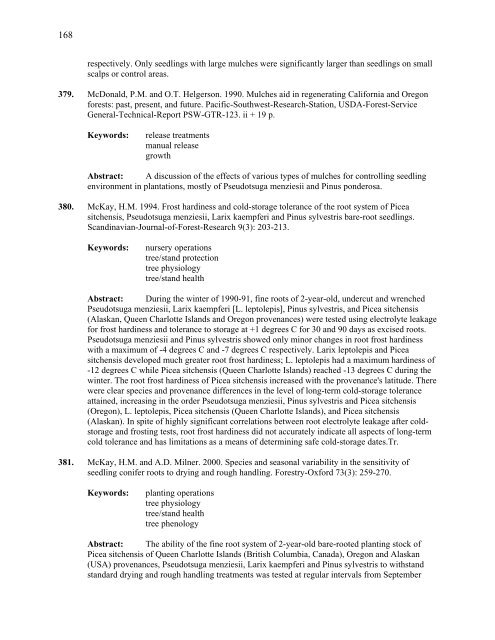IntensIve sIlvIculture - Forest Science Labs - Research Network ...
IntensIve sIlvIculture - Forest Science Labs - Research Network ...
IntensIve sIlvIculture - Forest Science Labs - Research Network ...
Create successful ePaper yourself
Turn your PDF publications into a flip-book with our unique Google optimized e-Paper software.
168<br />
respectively. Only seedlings with large mulches were significantly larger than seedlings on small<br />
scalps or control areas.<br />
379. McDonald, P.M. and O.T. Helgerson. 1990. Mulches aid in regenerating California and Oregon<br />
forests: past, present, and future. Pacific-Southwest-<strong>Research</strong>-Station, USDA-<strong>Forest</strong>-Service<br />
General-Technical-Report PSW-GTR-123. ii + 19 p.<br />
Keywords: release treatments<br />
manual release<br />
growth<br />
Abstract: A discussion of the effects of various types of mulches for controlling seedling<br />
environment in plantations, mostly of Pseudotsuga menziesii and Pinus ponderosa.<br />
380. McKay, H.M. 1994. Frost hardiness and cold-storage tolerance of the root system of Picea<br />
sitchensis, Pseudotsuga menziesii, Larix kaempferi and Pinus sylvestris bare-root seedlings.<br />
Scandinavian-Journal-of-<strong>Forest</strong>-<strong>Research</strong> 9(3): 203-213.<br />
Keywords: nursery operations<br />
tree/stand protection<br />
tree physiology<br />
tree/stand health<br />
Abstract: During the winter of 1990-91, fine roots of 2-year-old, undercut and wrenched<br />
Pseudotsuga menziesii, Larix kaempferi [L. leptolepis], Pinus sylvestris, and Picea sitchensis<br />
(Alaskan, Queen Charlotte Islands and Oregon provenances) were tested using electrolyte leakage<br />
for frost hardiness and tolerance to storage at +1 degrees C for 30 and 90 days as excised roots.<br />
Pseudotsuga menziesii and Pinus sylvestris showed only minor changes in root frost hardiness<br />
with a maximum of -4 degrees C and -7 degrees C respectively. Larix leptolepis and Picea<br />
sitchensis developed much greater root frost hardiness; L. leptolepis had a maximum hardiness of<br />
-12 degrees C while Picea sitchensis (Queen Charlotte Islands) reached -13 degrees C during the<br />
winter. The root frost hardiness of Picea sitchensis increased with the provenance's latitude. There<br />
were clear species and provenance differences in the level of long-term cold-storage tolerance<br />
attained, increasing in the order Pseudotsuga menziesii, Pinus sylvestris and Picea sitchensis<br />
(Oregon), L. leptolepis, Picea sitchensis (Queen Charlotte Islands), and Picea sitchensis<br />
(Alaskan). In spite of highly significant correlations between root electrolyte leakage after coldstorage<br />
and frosting tests, root frost hardiness did not accurately indicate all aspects of long-term<br />
cold tolerance and has limitations as a means of determining safe cold-storage dates.Tr.<br />
381. McKay, H.M. and A.D. Milner. 2000. Species and seasonal variability in the sensitivity of<br />
seedling conifer roots to drying and rough handling. <strong>Forest</strong>ry-Oxford 73(3): 259-270.<br />
Keywords: planting operations<br />
tree physiology<br />
tree/stand health<br />
tree phenology<br />
Abstract: The ability of the fine root system of 2-year-old bare-rooted planting stock of<br />
Picea sitchensis of Queen Charlotte Islands (British Columbia, Canada), Oregon and Alaskan<br />
(USA) provenances, Pseudotsuga menziesii, Larix kaempferi and Pinus sylvestris to withstand<br />
standard drying and rough handling treatments was tested at regular intervals from September
















